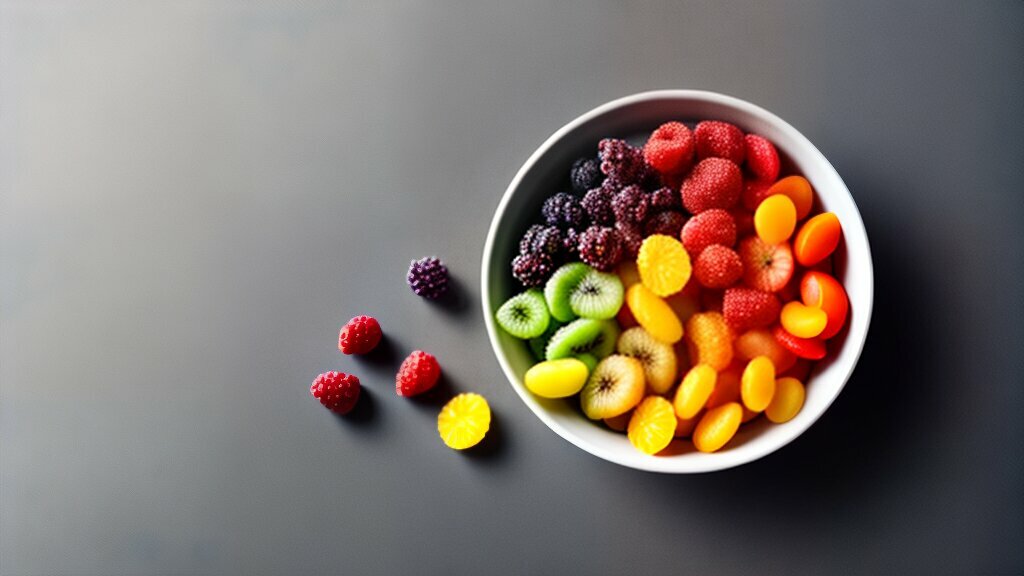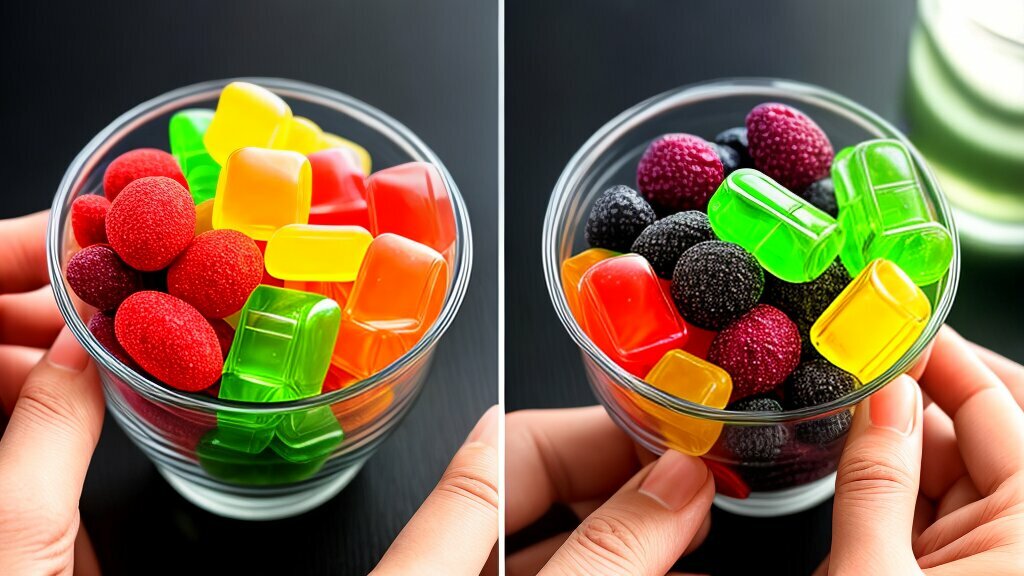Have you ever found yourself standing in the snack hall at the grocery store, trying to decide between gummies and fruit snacks? While both snacks may look similar initially, some significant differences set them apart. This article will explore the factors differentiating gummies from fruit snacks, including texture, ingredients, nutritional value, accessibility, taste preferences, and snack suitability.
Key takeaways:
- Gummies and fruit snacks may look similar, but the two have significant differences.
- The texture, ingredients, nutritional value, accessibility, taste preferences, and snack suitability are all factors that differentiate gummies from fruit snacks.
What are Gummies?
Gummies are soft, chewy candies made primarily from gelatin, sugar, corn syrup, and water. They come in various shapes, sizes, and flavors, ranging from classic bear-shaped gummies to more complex designs like fruit slices and worms. Some gummies may also contain fruit juice or natural flavors to enhance their taste.
One main characteristic that sets gummies apart from other candies, like fruit snacks, is their texture. Gummies are typically softer and chewy than fruit snacks, which can be firmer and have a more fibrous texture.

Gummies have been around for over a century, with the first gummy candy being developed in Germany in the early 1900s. Today, gummies are a popular snack among people of all ages and can be found in grocery stores, candy shops, and convenience stores worldwide.
What are Fruit Snacks?
As their name suggests, fruit snacks are made primarily from fruit juice, fruit puree, and other natural ingredients such as pectin. They are commonly found in slight, chewy, and gummy-like pieces like gummies. However, unlike gummies, fruit snacks do not usually contain added sugar or unnatural flavors and colors.
One advantage of fruit snacks over gummies is that they are generally considered healthier due to their natural ingredients and lack of added sugar and other artificial additives. For those seeking a healthier alternative to gummy snacks, fruit snacks can be a great choice.
Another difference between gummies and fruit snacks is their texture. While gummies are often chewy and stretchy, fruit snacks are softer and easier to consume. This texture may appeal to those who prefer a less intense chewing experience.
Unlike gummies, fruit snacks also tend to have a wider variety of flavors, as they are made from different fruit juices. Some popular fruit snack flavors include grape, strawberry, raspberry, and cherry.

“Fruit snacks, as their name suggests, are made primarily from fruit juice, fruit puree, and other natural ingredients such as pectin.”
Texture and Consistency
One of the most noticeable differences between gummies and fruit snacks is their texture and consistency.
Gummies have a chewy, gel-like texture that is consistent throughout each piece. This texture is achieved through gelatin, a protein made from animal collagen, which is heated and then cooled to create a gel-like substance. Gummies also often have a sugary coating, which gives them a little crunchy texture on the outside.
Fruit snacks, on the other hand, have a softer, more pliable texture. They are typically made from fruit puree or juice concentrate, blended with other ingredients like pectin, sugar, and citric acid. This mixture is then heated, cooled, and cut into small pieces. Fruit snacks often have a smoother texture than gummies, but they can also be slightly sticky or tacky to the touch.
Overall, the texture and consistency of gummies and fruit snacks are pretty different, which can be a determining factor for some consumers when choosing between the two snack options.

Ingredients of Gummies and Fruit Snacks
One of the primary differences between gummies and fruit snacks is the ingredients used to make them. While both contain fruit flavors, gummies are typically made with gelatin, sugar, water, and other additives such as corn syrup and food coloring to give them distinctive texture and appearance.
On the other hand, fruit snacks are made with real fruit puree or juice, along with other natural elements such as pectin and citric acid. This results in a softer, chewier texture that some people prefer over the denser consistency of gummies.
| Gummies | Fruit Snacks |
|---|---|
| Gelatin | Fruit puree or juice |
| Sugar | Pectin |
| Water | Citric acid |
| Corn syrup | Other natural ingredients |
It is important to note that not all gummies and fruit snacks are created equal, and some may contain more artificial ingredients than others. When choosing between the two, it is always a good idea to read the labels carefully and opt for brands that use natural and wholesome ingredients.

Nutritional Value
There is a stark contrast between gummies and fruit snacks regarding nutritional value. While fruit snacks are often marketed as healthier, especially for children, gummies tend to have higher sugar content and fewer nutrients.
Fruit snacks, as the name implies, are made from natural fruit and thus contain more vitamins and minerals than gummies. However, fruit snacks also tend to have added sugars and preservatives to maintain their shelf life.
On the other hand, gummies are typically made with artificial flavors and colors and are often coated in sugar or sour powder. This means that they offer little nutritional value beyond carbohydrates and calories.
Not all gummies and fruit snacks are created equal, so checking the nutrition label before consuming is essential. Look for options with the tiniest added sugars and ingredients you can recognize.
If you’re looking for a healthier option, fruit snacks are likely your best bet. However, gummies can be fun and indulgent if you want a sweet treat.

Accessibility and Availability
Both gummies and fruit snacks are widely available in grocery stores, amenity stores, and online retailers. However, there are some differences in their accessibility and availability.
Gummies are often more readily available and may come in larger quantities, making them popular for parties and events. They are also commonly found in the candy aisle of stores, meaning they may be more visible and easier to find for shoppers.
On the other hand, fruit snacks may be located in the snack aisle and marketed toward parents and children as a healthier snack option. Some brands may be sold exclusively in health food stores or specialty shops.
It’s important to note that availability may vary depending on the brands and varieties of gummies and fruit snacks. Some brands may only be available regionally or online, while others may be found in stores nationwide.
Image alt: accessibility and availability of gummies and fruit snacks

Taste Preferences
Taste preferences are personal and can vary from person to person. Some individuals may prefer gummy snacks due to their chewy and soft texture, while others may prefer fruit snacks for their natural fruity flavors.
However, it is essential to note that the taste of gummies and fruit snacks can be influenced by the ingredients used. Gummies are typically made with gelatin, which can have a distinct taste and texture, while fruit snacks are often made with real fruit puree or juices, resulting in a more authentic fruity flavor.
Some gummy snacks may also contain artificial flavors and additives to enhance their taste, while fruit snacks may have added sugars to improve their sweetness. Reading the ingredients list and nutrition label to determine which option suits your taste preferences and dietary needs is essential.

Snack Suitability
Gummy and fruit snacks have unique qualities that suit different situations. It all boils down to personal preference and the specific needs of the snack.
With their chewy texture and sweetness, gummies are ideal for satisfying a sweet tooth or providing a quick burst of energy. They are also a favorite among children who love the fun shapes and flavors. However, gummies may not be the best option for those observing sugar intake or seeking a healthier snack.
On the other hand, fruit snacks are a healthier alternative to gummies. They are usually made from natural fruit and do not contain added sugars or artificial colors. Fruit snacks are ideal for health-conscious people looking for nutritious snacks to fuel their day. They are also suitable for packed lunches or as a quick, on-the-go snack.
In summary, gummies and fruit snacks have their place and purpose in snacking. Whether you prefer the sweet and chewy texture of gummies or the natural and nutritious goodness of fruit snacks, both are great options for satisfying your snack cravings.

Conclusion
In conclusion, while gummies and fruit snacks share some similarities, they also have striking differences. Gummies are generally chewy, with a gummy texture, and come in various shapes and flavors. On the other hand, fruit snacks are chewy and softer, often made from natural fruit or fruit concentrates.
Regarding ingredients, gummies are mainly made from gelatin, sugar, and syrup, while fruit snacks contain fruit puree, concentrates, and pectin. Regarding nutritional value, fruit snacks are considered healthier than gummies due to their lower sugar and higher fiber content.
While accessibility and availability of these snacks vary by region, gummies are more commonly found in candy stores, while fruit snacks are more readily available in grocery stores.
Lastly, taste and snack suitability are highly subjective and depend on personal preferences. However, the nutritional benefits of fruit snacks make them a better option for those looking for a healthier snack alternative.
In conclusion, gummies and fruit snacks have unique features, and choosing one that best suits your taste and dietary requirements is essential.

Welcome to GummiesInfo.com, your go-to hub for all things gummy, curated by yours truly, Jimmy Chamberlin. With an unbridled passion for wellness and a relentless curiosity about gummies, I’m here to provide insightful guides that make your journey to better health both flavorful and enjoyable. My foray into health and wellness began as a mission to find practical, enjoyable ways to enhance well-being.
This odyssey led me to dive deep into the realm of gummies, exploring their benefits, ingredients, and impact on health. GummiesInfo.com stands apart through my hands-on approach. I won’t settle for superficial knowledge – I dig deep to uncover the finest gummy options. By scrutinizing ingredients, evaluating formulations, and conducting real-world tests, I’m here to guide you toward optimal choices. From gummy essentials to detailed health-specific insights like immunity, energy, and relaxation, GummiesInfo.com is your trusted companion. Join me in discovering the potential of gummies – together; we’ll journey towards wellness, one flavorful gummy at a time.
Yours in wellness,
Jimmy Chamberlin